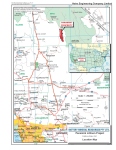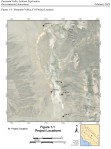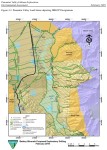Battery Mineral Resources Panamint Valley
Posted July 27, 2020
The Panamint Valley lithium project is located close to Death Valley National Park and Sunrise Canyon Wilderness Area to the north and east. The China Lake US Naval Air Weapons station is located to the west and south of the project area.
The Panamint Valley area has seen extensive exploration and development since the early 1870s. Most of this activity has been concentrated in Searles Valley, immediately adjacent to Panamint Valley.
Borax was discovered in the Searles Lake area in 1873 and production of Borax began in 1874. In 1905 the soda ash potential of the lake was recognized, which started economic development that ultimately led to the current production activities in the area.
In 1908 the California Trona Company staked claims on much of the deposit area and borrowed significant capital for development. The company went into receivership the following year and the receiver continued exploration and development on the project.
By 1914, California Trona Company had reorganized, constructed a small plant, and laid the Trona Railway. The new plant never produced, and the operation was idled until 1916, when another new plant was finished, and commercial production of potash was started due to the European supply being cut off.
In 1920 the American Trona Company continued commercial production under poor economic conditions and following World War I added borax to its production and started a lengthy plant redesign. The West End Chemical Company at the settlement of West End, was formed and produced borax produced until 1927 when the plant was redesigned for soda ash production. Borax production restarted in 1930 and production of sodium sulphate began in 1955. American Trona Company merged into the American Potash and Chemical Corporation and developed new processes and new products.
In 1956 Stauffer Chemical Company took over the West End Company. In 1967 Kerr-McGee absorbed the American Potash & Chemical Corporation In 1974, the Kerr-McGee Chemical Corporation purchased Stauffer’s West End plant. The chemical plants at Trona and West End operated under one ownership.
Both plants extracted chemicals from brine pumped from saline layers underneath the dry lake surface. The plant at Trona produced sodium carbonate and sulfate, potassium chloride and sulfate, lithium carbonate, sodium borate, phosphoric acid and bromine. The plant at West End produced sodium carbonate, sodium borate and sodium sulfate. Annual production from both plants was valued at about $30 million, and total production since 1926 exceeded $1 billion by 1978.
The Searles Lake Chemical Corporation, (a subsidiary of Occidental Petroleum) facilities near the south edge of the lake were under development in the early 1970s by two subsidiary companies, Garrett Research and Development Co. and the Hooker Chemical Corp. Production was planned to include sodium borate, sodium carbonate, and potassium sulfate through solar evaporation and plant processes.
Searles Valley Minerals produces soda ash and sodium bicarbonate from their Argus plant, refrigerates a mixture of carbonated brine and lake brine to produce sodium sulfate and primary borax at their Westend Plant, and either refines those products into pentahydrate borax or transports them to their Trona Plant. The Trona Plant refines primary borax from the Westend Plant into decahydrate borax and anhydrous borax and uses a solvent extraction and evaporation process to produce boric acid. Salt is produced on the lake using a solar evaporation process. The Argus Utilities Plant produces steam and electricity, mostly for use in the plants.
The proposal for the Panamint Valley lithium project is by Australian-based Battery Mineral Resources (BMR). The company is an early stage mineral exploration company with a focus on lithium, cobalt and graphite projects. Lithium, cobalt, and graphite are key raw materials used in the production of lithium ion batteries and other energy storage applications. BMR intends to develop a portfolio of lithium, cobalt, and graphite projects in various jurisdictions.
BMR’s lithium project assets consist of three properties: Panamint Valley Property located in Inyo County, California, the Amargosa Property located in Nye County, Nevada, and the Franklin Wells Property located in Inyo County, California. Only the Panamint property is considered a “Material Property” as defined by the Toronto Stock Exchange and is considered a “Property of Merit.”
The Panamint Valley property is considered prospective for lithium brine. The geological characteristics of the region and the property are like those of Clayton Valley, Nevada, which is the only production center for lithium in the United States. The more southerly end of the property is regarded as having the greatest potential for hosting lithium brines, although it is likely lithium brine will be found at grater depths than in the more northerly portions of the property.
The BMR Panamint Valley project, located immediately west of Death Valley National Park, is comprised of 56,557 acres held as Federal placer mining claims and State of California prospecting permits.
The Panamint Valley lithium project property has been subject to limited geological research drilling by the United States Geological Survey. No other work has been undertaken on the property. The property is defined as an early stage exploration property and there is no existing infrastructure.
There are no immediately adjacent properties except for the now closed Ballarat gold mine. The Searles Lake brine operation is located approximately 12 miles to the west. This operation produces soda ash and borates and previously produced lithium carbonate on a limited scale.
Nov. 15, 2017, Battery Mineral Resources (BMR) submitted their plan of operations for the Panamint Valley lithium exploration project to the Bureau of Land Management (BLM). The project is located on four unpatented placer mining claims on public land. The BLM will now decide whether to approve, approve with modification, or deny the proposal presented by BMR. The BLM issued their environmental assessment February 2019. The BLM opened public comments on the project March 15, 2019, and the public comment period ended April 15, 2019.
In a financial statement dated June 30, 2018, obtained from the website of Battery Mineral Resources, the following item is noted; “In May 2018 Weston Energy LLC, a director-related entity of Lazaros Nikeas, provided $2,662,400 (USD 2m) to finance a lithium drilling program in Panamint Valley, California USA.” On the BMR website Lazaros Nikeas is listed as the “Executive Chairman, partner of Weston Energy LLC, a Yorktown Partners LLC portfolio company. Mr. Nikeas was previously a Partner of Traxys Capital Partners, a resource investment firm backed by the Carlyle Group. Mr. Nikeas has over 15 years of strategy and capital markets advisory experience for resource, chemicals and industrial companies, with over US$25 billion of M&A transactions completed.”
April 5, 2019, the Friends of the Inyo, a public lands advocate founded in 1986, published an action alert on the proposed lithium mine in Panamint Valley. The group noted that lithium is needed for a renewable future, lithium mines should be located in appropriate places and not in places like Panamint Valley which is adjacent to Death Valley National Park, heavily used by a variety of recreationists, and home to rare plant species and wildlife.
The group went on to say that “Panamint Valley is a unique and special treasure. It is as deep as Death Valley and even more narrow. Surrounded by striking mountains, such as Telescope Peak, there are several recreational opportunities for those seeking adventure and solitude. Panamint Valley is the only remaining valley managed by the BLM Ridgecrest Field Office that is not developed. It was designated as California Desert National Conservation Land and is to be managed to protect its conservation and recreation values. Imagine seeing from a high peak in the Panamint Range neon colored pools of toxic solutions.”
May 17, 2019, a Los Angeles Times report published in The Seattle Times titled “A war is brewing over lithium mining at the edge of Death Valley” takes a detailed look at the Panamint Valley lithium project.
Aug. 9, 2019, the Bureau of Land Management announced that after the environmental review of the Panamint Valley lithium project there was no finding of significant impact (FONSI) and BMR would be allowed to proceed with its Plan of Operations.
Aug. 17, 2019, the Inyo Register reported “BLM approves lithium study in Panamint Valley – Potential mining would take years to develop” and discussed other lithium projects in the county.
Aug. 27, 2019, the Friends of the Inyo published an update to the lithium mine project which included disappointment that the project was approved by the Bureau of Land Management.
Nov. 10, 2019, the Friends of the Inyo published an update on the Panamint Valley lithium project that outlined their concerns and plan of action. The article also reported that there is a pending exploration permit for lithium on State School Land directly adjacent to the BLM drill sites. The State Lands Commission recently reviewed the proposal and is considering a categorical exclusion under the California Environmental Quality Act (CEQA). The group submitted comments to the School Lands Commission expressing why this initial exploration should be subject to CEQA because of cumulative impacts to groundwater and the associated drilling on public lands.
Nov. 14, 1019, the Inyo Register reported “Lithium ‘booms’ north and south of Inyo – Canadian mining firm could develop mining operation in Panamint Valley.” The article also discusses Rio Tinto’s pilot lithium plant, lithium production at Albemarle’s Silver Peak mine and other lithium projects in the area.
Feb. 3, 2020, the Friends of the Inyo published an update indicating that the Panamint Valley lithium project was upheld through all levels of the National Environmental Policy Act (NEPA). The group put out a call to volunteers to help the group monitor the project and drill sites.
Sources: Historical mining information provided by the Technical Report on the Panamint Valley Lithium Project by Donald H. Hains, P.Geo.
Battery Mineral Resources Panamint Valley on Google Maps
Battery Mineral Resources website
(Please notify author on the website contact page for errors, omissions or suggestions.)









